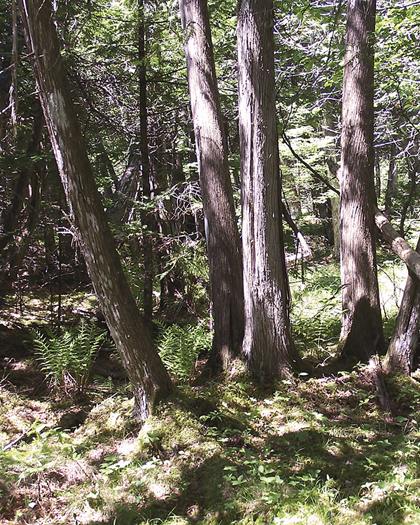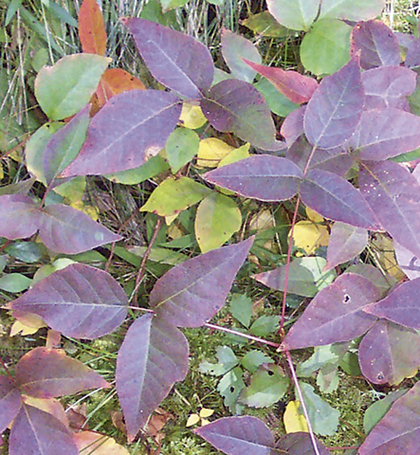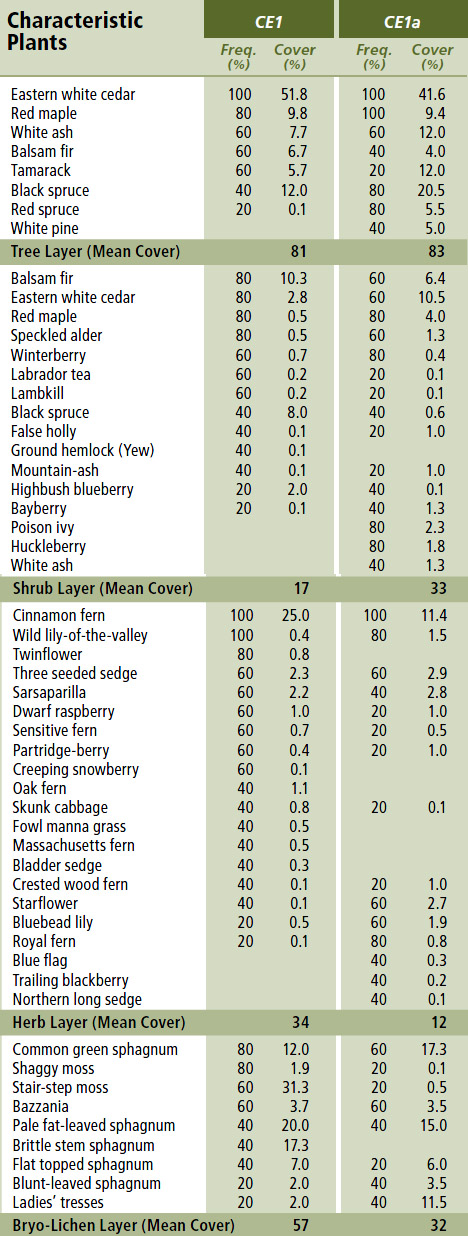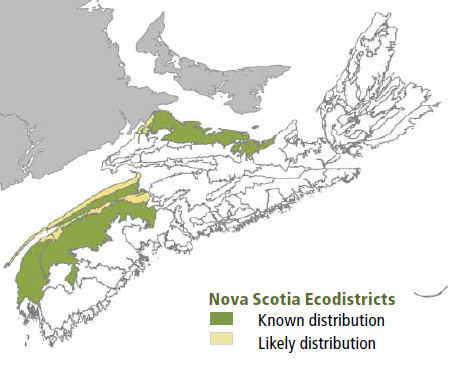
Forest Vegetation types - CE1
CE1 — Eastern white cedar / Speckled alder / Cinnamon fern /Sphagnum
Thuja occidentalis / Alnus incana / Osmunda cinnamonea / Sphagnum spp.
CE1a — Poison ivy variant
Toxicodendron radicans
 |
| Oxford Junction, Cumberland county |
Concept: This mid to late successional ecosystem is the only wet cedar forest found in Nova Scotia. The very uncommon Eastern white cedar / Speckled alder / Cinnamon fern / Sphagnum forest is characterized by cedar canopy dominance and moderate to high levels of sphagnum. CE1a, the poison ivy variant, is typified by species with Atlantic Coastal Plain affinity (e.g. poison ivy, inkberry, Elliott's goldenrod, catbriar and others).
Vegetation: Canopy layers are well developed, with moderate to high levels of cedar and lesser amounts of red maple, black spruce and white ash. Woody understory and herbaceous layers are variably developed. Common species include speckled alder, winterberry, cinnamon fern and three seeded sedge. Occurrences of CE1a may include poison ivy, huckleberry, inkberry, skunk cabbage, Elliott's goldenrod, catbriar and/or button sedge, as well as other Atlantic Coastal Plain species. The typically dense bryophyte layer includes prominent common green sphagnum.
Environmental Setting: The Eastern white cedar / Speckled alder / Cinnamon fern / Sphagnum forest usually occurs on poorly to very poorly drained flats and depressions, scattered at low elevation across western and northern Nova Scotia. Most stands are supported by nutrient medium to rich organic soil, but poorly drained mineral soil also provides suitable habitat for this Vegetation Type (VT). Sites are moderately exposed with little microtopography or surface stoniness. In Yarmouth and Digby counties, lakeside stands can occur on elevated terraces or ridges called ice ramparts. These terraces are formed by the shoreward movement and pushing action of ice during winter freeze up. The VT is much more common in both New Brunswick and Prince Edward Island, although less so in the latter province. CE1a is not found outside Nova Scotia.
Successional Dynamics: Successional patterns of this mid to late successional Vegetation Type are not fully understood. Most occurrences are maintained by gap dynamics, but some stands show evidence of small-scale timber harvest, a disturbance agent that generally favours black spruce, balsam fir and/or tamarack regeneration. Windthrow, harvesting, flooding and ice scour are potential stand-level disturbance agents. Depending on the disturbance regime, site fertility and local seed sources, CE1 could transition from WD4 (Red maple / Poison ivy / Sphagnum) or WC7 (Tamarack - Black spruce / Lambkill / Sphagnum). Between major disturbance events, natural tree senescence promotes uneven age class development and related changes in stand structure.
Ecological Features: Occurrences of this small patch ecosystem rarely cover a hectare. The variably composed overstory provides moderate to dense canopy cover. Deer may browse cedar heavily in winter, while snowshoe hare eat the foliage and gnaw young treebark. Cedar are long-lived and resistant to disease and insects. The oldest Nova Scotia trees exceed 250 years. Cedar wood is very decay resistant resulting in dead trees that may persist for many decades. Cedar is legally protected and listed as vulnerable under the Nova Scotia Endangered Species Act.
 |
| Poison Ivy |
Distinguishing Features: These are wet softwood forests with cedar. The variant, CE1a, displays a strong Atlantic Coastal Plain flora affinity in the understory. Species such as poison ivy, inkberry, Elliott's goldenrod and others are often present.
| Slope Position: | Level7 Depression2 Lower1 |
Surface Stoniness: |
(Non - Slightly)8 (Moderately)1 (Very - Excessively)1 |
Bedrock Outcrop: |
(Non-rocky)10 |
Elevation Range: |
14 - 168m |
Slope Gradient: |
Level9 Moderate1 |
Aspect: |
South1 None9 |
Exposure: |
Moderate7 Mod. sheltered2 Sheltered1 |
Microtopography: |
Level6 Slightly2 Moderately1 nd1 |
Drainage: |
Very poor5 Poor4 nd1 |
Soil Type: |
ST149 ST41 |
Parent Material: |
Organic9 Lacustrine1 |
Rooting Depth (cm): |
(<30)4 (30-45)1 nd5 |
Duff Thickness (cm): |
(21-40)1 (>40)9 |

